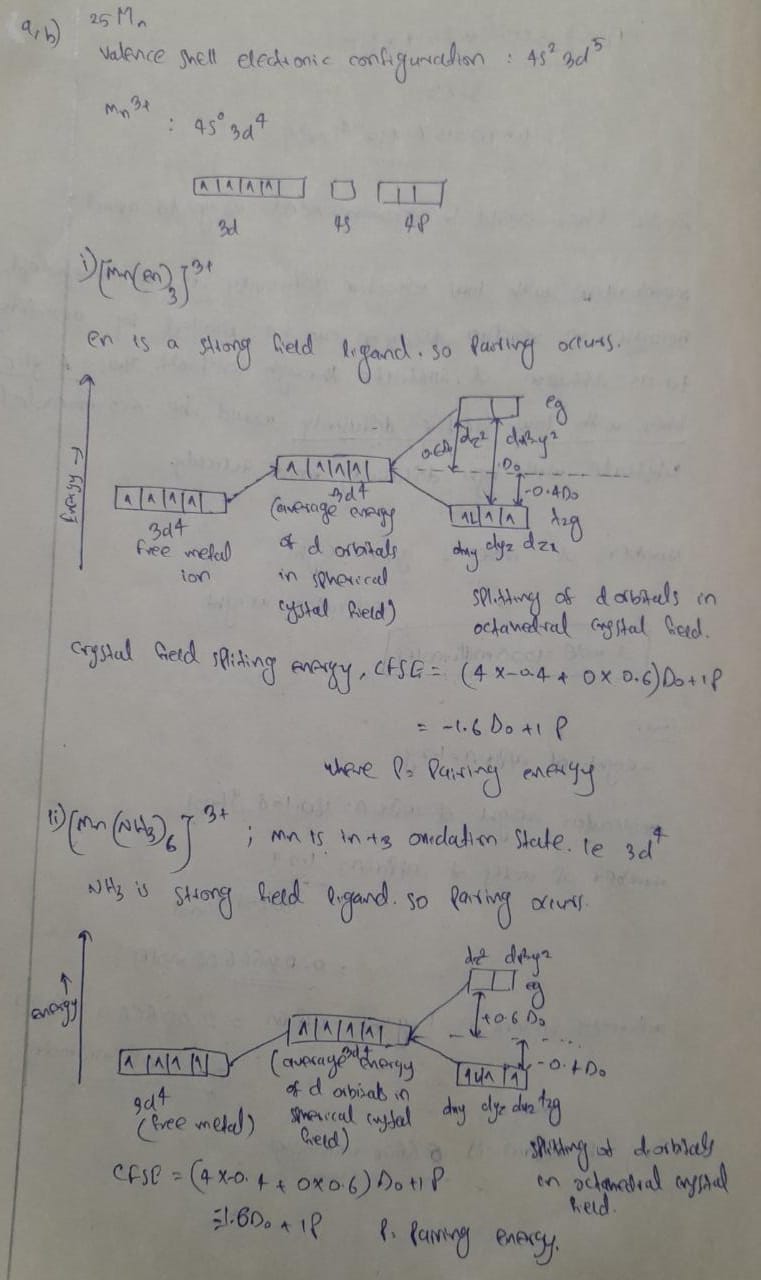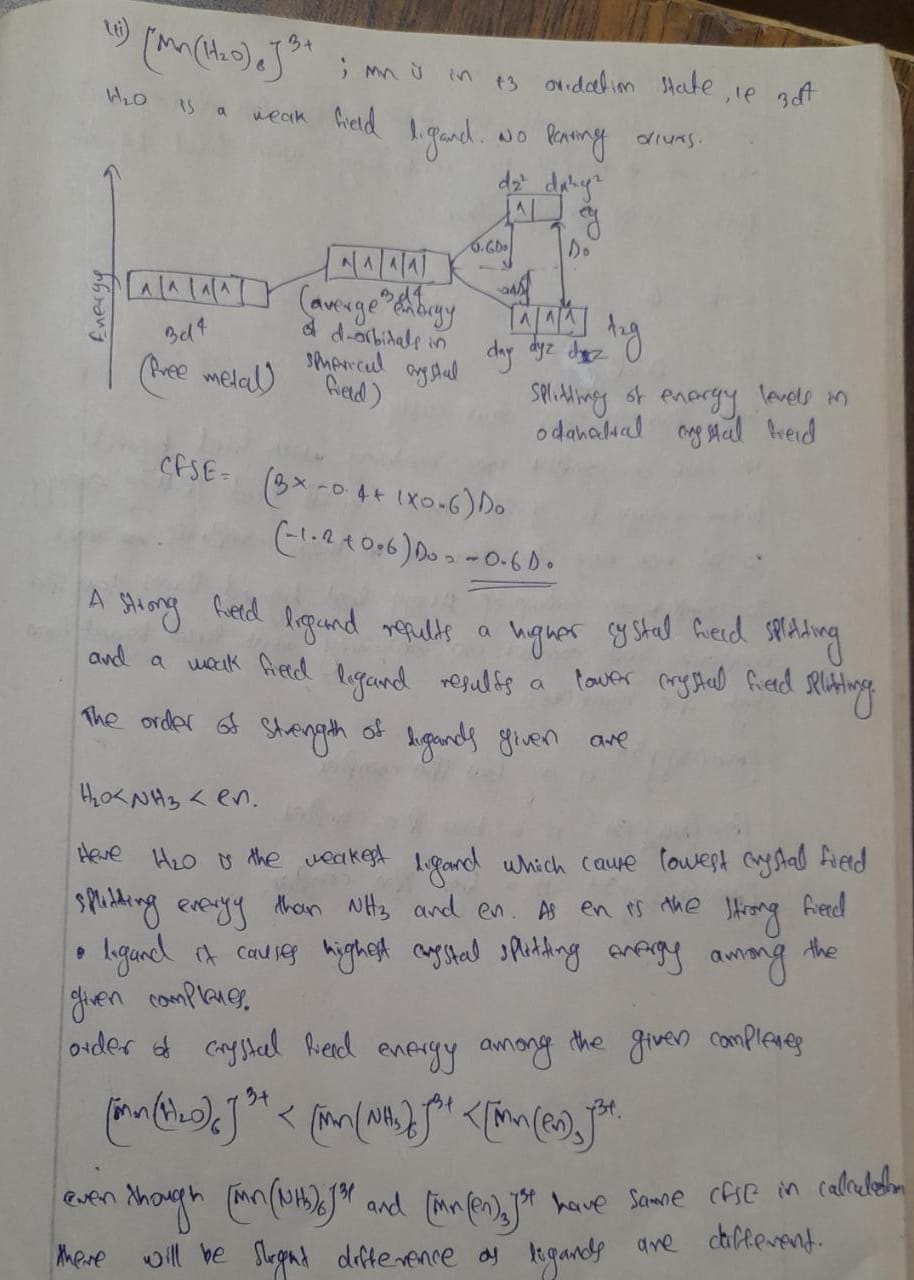8. Consider the number of d-electrons for Mn³+ and the ligand strength of the ligands, H₂O en, and NH3. a) Draw the splitting energy diagram for the ground state of each of the three octahedral complex ions, Mn(en)3³+ (aq), Mn(NH3)6³+ (aq), and Mn(H₂O)6³+ (aq). In the diagrams, show how the d-orbitals compare energetically between these three Mn³+ complex ions. (Hint: Think about the relative ligand strengths.) b) Label ONE of these energy diagrams each d-orbital with its designation, dxy, dyz, etc... c) Considering the electronic configurations in the splitting energy diagrams in part a, explain why the electron configuration in the splitting energy diagram for the complex ion containing the weak field ligands is different than the electronic configurations in the splitting diagrams for the complex ions containing the strong field ligands.
8. Consider the number of d-electrons for Mn³+ and the ligand strength of the ligands, H₂O en, and NH3. a) Draw the splitting energy diagram for the ground state of each of the three octahedral complex ions, Mn(en)3³+ (aq), Mn(NH3)6³+ (aq), and Mn(H₂O)6³+ (aq). In the diagrams, show how the d-orbitals compare energetically between these three Mn³+ complex ions. (Hint: Think about the relative ligand strengths.) b) Label ONE of these energy diagrams each d-orbital with its designation, dxy, dyz, etc... c) Considering the electronic configurations in the splitting energy diagrams in part a, explain why the electron configuration in the splitting energy diagram for the complex ion containing the weak field ligands is different than the electronic configurations in the splitting diagrams for the complex ions containing the strong field ligands.
Chemistry
10th Edition
ISBN:9781305957404
Author:Steven S. Zumdahl, Susan A. Zumdahl, Donald J. DeCoste
Publisher:Steven S. Zumdahl, Susan A. Zumdahl, Donald J. DeCoste
Chapter1: Chemical Foundations
Section: Chapter Questions
Problem 1RQ: Define and explain the differences between the following terms. a. law and theory b. theory and...
Related questions
Concept explainers
Atomic Structure
The basic structure of an atom is defined as the component-level of atomic structure of an atom. Precisely speaking an atom consists of three major subatomic particles which are protons, neutrons, and electrons. Many theories have been stated for explaining the structure of an atom.
Shape of the D Orbital
Shapes of orbitals are an approximate representation of boundaries in space for finding electrons occupied in that respective orbital. D orbitals are known to have a clover leaf shape or dumbbell inside where electrons can be found.
Question

Transcribed Image Text:8. Consider the number of d-electrons for Mn³+ and the ligand strength of the ligands, H₂O,
en, and NH3.
a) Draw the splitting energy diagram for the ground state of each of the three octahedral
complex ions, Mn(en)3³+ (aq), Mn(NH3)6³+ (aq), and Mn(H₂O)6³+ (aq). In the diagrams, show
how the d-orbitals compare energetically between these three Mn³+ complex ions. (Hint:
Think about the relative ligand strengths.)
b) Label ONE of these energy diagrams each d-orbital with its designation, dxy, dyz, etc...
c) Considering the electronic configurations in the splitting energy diagrams in part a,
explain why the electron configuration in the splitting energy diagram for the complex
ion containing the weak field ligands is different than the electronic configurations in the
splitting diagrams for the complex ions containing the strong field ligands.
Expert Solution
Step 1
 l
l
Trending now
This is a popular solution!
Step by step
Solved in 2 steps with 4 images

Knowledge Booster
Learn more about
Need a deep-dive on the concept behind this application? Look no further. Learn more about this topic, chemistry and related others by exploring similar questions and additional content below.Recommended textbooks for you

Chemistry
Chemistry
ISBN:
9781305957404
Author:
Steven S. Zumdahl, Susan A. Zumdahl, Donald J. DeCoste
Publisher:
Cengage Learning

Chemistry
Chemistry
ISBN:
9781259911156
Author:
Raymond Chang Dr., Jason Overby Professor
Publisher:
McGraw-Hill Education

Principles of Instrumental Analysis
Chemistry
ISBN:
9781305577213
Author:
Douglas A. Skoog, F. James Holler, Stanley R. Crouch
Publisher:
Cengage Learning

Chemistry
Chemistry
ISBN:
9781305957404
Author:
Steven S. Zumdahl, Susan A. Zumdahl, Donald J. DeCoste
Publisher:
Cengage Learning

Chemistry
Chemistry
ISBN:
9781259911156
Author:
Raymond Chang Dr., Jason Overby Professor
Publisher:
McGraw-Hill Education

Principles of Instrumental Analysis
Chemistry
ISBN:
9781305577213
Author:
Douglas A. Skoog, F. James Holler, Stanley R. Crouch
Publisher:
Cengage Learning

Organic Chemistry
Chemistry
ISBN:
9780078021558
Author:
Janice Gorzynski Smith Dr.
Publisher:
McGraw-Hill Education

Chemistry: Principles and Reactions
Chemistry
ISBN:
9781305079373
Author:
William L. Masterton, Cecile N. Hurley
Publisher:
Cengage Learning

Elementary Principles of Chemical Processes, Bind…
Chemistry
ISBN:
9781118431221
Author:
Richard M. Felder, Ronald W. Rousseau, Lisa G. Bullard
Publisher:
WILEY